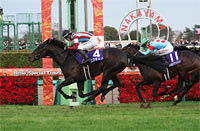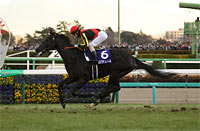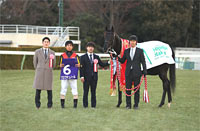Hopeful Stakes (G1) - Data Analysis
Two-year-old champion decider that has produced various types of famous names
Among the nine winners since 2014, when the race was renamed from Radio Nikkei Hai Nisai Stakes to Hopeful Stakes and moved to Nakayama Racecourse, 2016 winner Rey de Oro, 2018 winner Saturnalia, and 2019 winner Contrail all went on to dominate the Classic races in the next spring. In addition, 2017 runner-up Gendarme won the Sprinters Stakes in 2022, 2020 fourth-place finisher Titleholder triumphed in the Kikuka Sho (Japanese St. Leger) and other races in 2021, and 2021 runner-up Justin Palace secured the victory in the Tenno Sho (Spring) in 2023. As its name suggests, the Hopeful Stakes is a closely watched race that brings together young runners with future promise. Let’s now analyze some features shared by successful runners in this race based on results over the last nine years, including the period from 2014 to 2016, when the Hopeful Stakes was still held as a G2 race.
Poor showing by runners coming straight from a major defeat
All 27 Top 3 finishers over the last nine years had finished either 1st in their previous race, or 2nd or lower with a time difference of 0.3s or less with the winner in that race. We should therefore lower our expectations of runners that have suffered a major defeat in their most recent race. [Table 1]
[Table 1] Performance by finish in previous race and time difference with winner in that race (last nine years)
Finish in previous race and time
difference with winner in that race |
Performance
[1st-2nd-3rd-4th or lower] |
Win ratio |
Top 2 ratio |
Top 3 ratio |
| 1st, or 2nd or lower with time difference with winner of 0.3s or less |
9-9-9-76 |
8.7% |
17.5% |
26.2% |
| 2nd or lower with time difference with winner of 0.4s or more |
0-0-0-31 |
0% |
0% |
0% |
Watch final sprint last time out
Of the 27 Top 3 finishers over the last nine years, 26 had contested a JRA race in their previous race and were ranked 3rd or higher in their estimated time over the final three furlongs in that race. Conversely, runners that had been ranked 4th or lower struggled with a Top 3 ratio of 2.6%. This suggests we should be skeptical of runners that were ranked poorly in their estimated time over the final three furlongs in their previous race. [Table 2]
[Table 2] Among runners that had contested a JRA race in their previous race, performance by ranking in estimated time over final three furlongs in that race (last nine years)
Ranking in estimated time over final
three furlongs in previous race |
Performance
[1st-2nd-3rd-4th or lower] |
Win ratio |
Top 2 ratio |
Top 3 ratio |
| 3rd or higher |
8-9-9-66 |
8.7% |
18.5% |
28.3% |
| 4th or lower |
1-0-0-38 |
2.6% |
2.6% |
2.6% |
Interval since previous race is key
Of the 18 Top 3 finishers in the six years since the Hopeful Stakes has been held as a G1 race, 17 entered the race four weeks or more since their previous race. Meanwhile, runners that entered the race three weeks or less struggled with a Top 3 ratio of 4.5%. When comparing the lead-up races of this year’s runners, we should raise our expectations of runners entering the race with a relatively comfortable interval since their previous race. [Table 3]
[Table 3] Performance by interval since previous race (last six years)
| Interval since previous race |
Performance
[1st-2nd-3rd-4th or lower] |
Win ratio |
Top 2 ratio |
Top 3 ratio |
| Three weeks or less |
0-0-1-21 |
0% |
0% |
4.5% |
| Four weeks or more |
6-6-5-52 |
8.7% |
17.4% |
24.6% |
Solid performance by runners that have won a 1-win class or open-class race
Of the 18 Top 3 finishers in the six years since the Hopeful Stakes has been held as a G1 race, 15 had experience of winning a 1-win class or higher-grade JRA turf race. Runners in this group achieved an excellent Top 3 ratio of 41.7%. We should therefore regard runners with experience of winning a turf race other than a newcomer or maiden race as leading contenders. [Table 4]
[Table 4] Performance by experience of winning a 1-win class or higher-grade JRA turf race (last six years)
| Experience |
Performance
[1st-2nd-3rd-4th or lower] |
Win ratio |
Top 2 ratio |
Top 3 ratio |
| Yes |
4-6-5-21 |
11.1% |
27.8% |
41.7% |
| No |
2-0-1-52 |
3.6% |
3.6% |
5.5% |
In addition, the three Top 3 finishers without experience of winning a 1-win class or higher-grade JRA turf race were all Ritto-trained and born in February or earlier. Among runners without experience of winning a turf race other than a newcomer or maiden race, we should focus on horses from Kansai stables born early in the year. [Table 5]
[Table 5] Among runners without experience of winning a 1-win class or higher-grade JRA turf race, performance by affiliation and month of birth (last six years)
| Affiliation and month of birth |
Performance
[1st-2nd-3rd-4th or lower] |
Win ratio |
Top 2 ratio |
Top 3 ratio |
| Ritto Training Center, and born in February or earlier |
2-0-1-8 |
18.2% |
18.2% |
27.3% |
| Other than Ritto Training Center, or born in March or later |
0-0-0-44 |
0% |
0% |
0% |
Runners starting in the inner brackets basically have the edge
Of the 18 Top 3 finishers in the six years since the Hopeful Stakes has been held as a G1 race, 13 entered the race with the numbers 1-8. Meanwhile, horses with the numbers 9-18 struggled somewhat with a Top 3 ratio of 11.6%. When making our selection, we should therefore lean toward runners starting in the inner brackets. [Table 6]
[Table 6] Performance by horse number (last six years)
| Horse number |
Performance
[1st-2nd-3rd-4th or lower] |
Win ratio |
Top 2 ratio |
Top 3 ratio |
| 1-8 |
4-5-4-35 |
8.3% |
18.8% |
27.1% |
| 9-18 |
2-1-2-38 |
4.7% |
7.0% |
11.6% |
In addition, three of the five runners that finished in the Top 3 despite entering the race with the numbers 9-18, had contested a graded race in their previous race, and had been positioned 5th or higher when passing the 4th corner in that race. Runners that had contested a non-graded race last time out or had been positioned 6th or lower when passing the 4th corner in their previous race, achieved a Top 3 ratio of only 5.4%. This suggests we should lower our expectations of runners starting in the outer brackets unless they led the pack in a graded major prep race. [Table 7]
[Table 7] Among runners that entered the race with the numbers 9-18, performance by previous race and position when passing the 4th corner in that race (last six years)
Previous race and position when
passing the 4th corner in that race |
Performance
[1st-2nd-3rd-4th or lower] |
Win ratio |
Top 2 ratio |
Top 3 ratio |
| Graded race last time out, and 5th or higher when passing the 4th corner |
2-1-0-3 |
33.3% |
50.0% |
50.0% |
| Non-graded race last time out, or 6th or lower when passing the 4th corner |
0-0-2-35 |
0% |
0% |
5.4% |
Seek out the winner!
Kanto-trained horses and runners starting in the outer brackets struggle to win
The winners in the six years since the Hopeful Stakes has been held as a G1 race, were all based at Ritto Training Center and started the race from brackets 1-11. As shown in Table 6, runners starting in the outermost brackets are hard to recommend. Other shared features among the last six winners were that they had finished either 1st in their previous race or 2nd or lower with a time difference of 0.2s or less with the winner in that race, and that they had entered the race four weeks or more since their previous race. This suggests we should also take into consideration the trends shown in Tables 1 and 3. [Table 8]
[Table 8] Winners’ trainer (affiliation), horse number, finish in previous race (time difference with winner), interval since previous race (last six years)
| Year |
Winner |
Horse trainer
(affiliation) |
Horse
number |
Finish in previous race (time
difference with winner) |
Interval since
previous race |
| 2017 |
Time Flyer |
Kunihide Matsuda (Ritto) |
7 |
2nd (0.0s) |
Within four weeks |
| 2018 |
Saturnalia |
Kazuya Nakatake (Ritto) |
5 |
1st |
Within eight weeks |
| 2019 |
Contrail |
Yoshito Yahagi (Ritto) |
2 |
1st |
Within five weeks |
| 2020 |
Danon the Kid |
Takayuki Yasuda (Ritto) |
10 |
1st |
Within four weeks |
| 2021 |
Killer Ability |
Takashi Saito (Ritto) |
5 |
2nd (0.0s) |
Within seven weeks |
| 2022 |
Dura Erede |
Manabu Ikezoe (Ritto) |
11 |
4th (0.2s) |
Within five weeks |
(Masaya Ibuki)
|



















